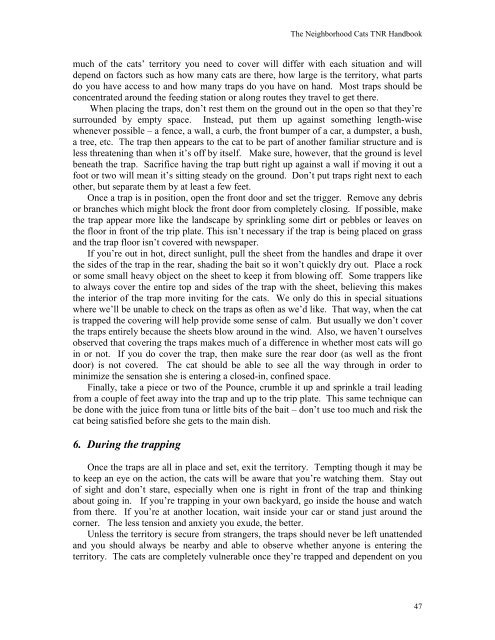Create successful ePaper yourself
Turn your PDF publications into a flip-book with our unique Google optimized e-Paper software.
The <strong>Neighborhood</strong> <strong>Cats</strong> <strong>TNR</strong> <strong>Handbook</strong><br />
much of the cats’ territory you need to cover will differ with each situation and will<br />
depend on factors such as how many cats are there, how large is the territory, what parts<br />
do you have access to and how many traps do you have on hand. Most traps should be<br />
concentrated around the feeding station or along routes they travel to get there.<br />
When placing the traps, don’t rest them on the ground out in the open so that they’re<br />
surrounded by empty space. Instead, put them up against something length-wise<br />
whenever possible – a fence, a wall, a curb, the front bumper of a car, a dumpster, a bush,<br />
a tree, etc. The trap then appears to the cat to be part of another familiar structure and is<br />
less threatening than when it’s off by itself. Make sure, however, that the ground is level<br />
beneath the trap. Sacrifice having the trap butt right up against a wall if moving it out a<br />
foot or two will mean it’s sitting steady on the ground. Don’t put traps right next to each<br />
other, but separate them by at least a few feet.<br />
Once a trap is in position, open the front door and set the trigger. Remove any debris<br />
or branches which might block the front door from completely closing. If possible, make<br />
the trap appear more like the landscape by sprinkling some dirt or pebbles or leaves on<br />
the floor in front of the trip plate. This isn’t necessary if the trap is being placed on grass<br />
and the trap floor isn’t covered with newspaper.<br />
If you’re out in hot, direct sunlight, pull the sheet from the handles and drape it over<br />
the sides of the trap in the rear, shading the bait so it won’t quickly dry out. Place a rock<br />
or some small heavy object on the sheet to keep it from blowing off. Some trappers like<br />
to always cover the entire top and sides of the trap with the sheet, believing this makes<br />
the interior of the trap more inviting for the cats. We only do this in special situations<br />
where we’ll be unable to check on the traps as often as we’d like. That way, when the cat<br />
is trapped the covering will help provide some sense of calm. But usually we don’t cover<br />
the traps entirely because the sheets blow around in the wind. Also, we haven’t ourselves<br />
observed that covering the traps makes much of a difference in whether most cats will go<br />
in or not. If you do cover the trap, then make sure the rear door (as well as the front<br />
door) is not covered. The cat should be able to see all the way through in order to<br />
minimize the sensation she is entering a closed-in, confined space.<br />
Finally, take a piece or two of the Pounce, crumble it up and sprinkle a trail leading<br />
from a couple of feet away into the trap and up to the trip plate. This same technique can<br />
be done with the juice from tuna or little bits of the bait – don’t use too much and risk the<br />
cat being satisfied before she gets to the main dish.<br />
6. During the trapping<br />
Once the traps are all in place and set, exit the territory. Tempting though it may be<br />
to keep an eye on the action, the cats will be aware that you’re watching them. Stay out<br />
of sight and don’t stare, especially when one is right in front of the trap and thinking<br />
about going in. If you’re trapping in your own backyard, go inside the house and watch<br />
from there. If you’re at another location, wait inside your car or stand just around the<br />
corner. The less tension and anxiety you exude, the better.<br />
Unless the territory is secure from strangers, the traps should never be left unattended<br />
and you should always be nearby and able to observe whether anyone is entering the<br />
territory. The cats are completely vulnerable once they’re trapped and dependent on you<br />
47


